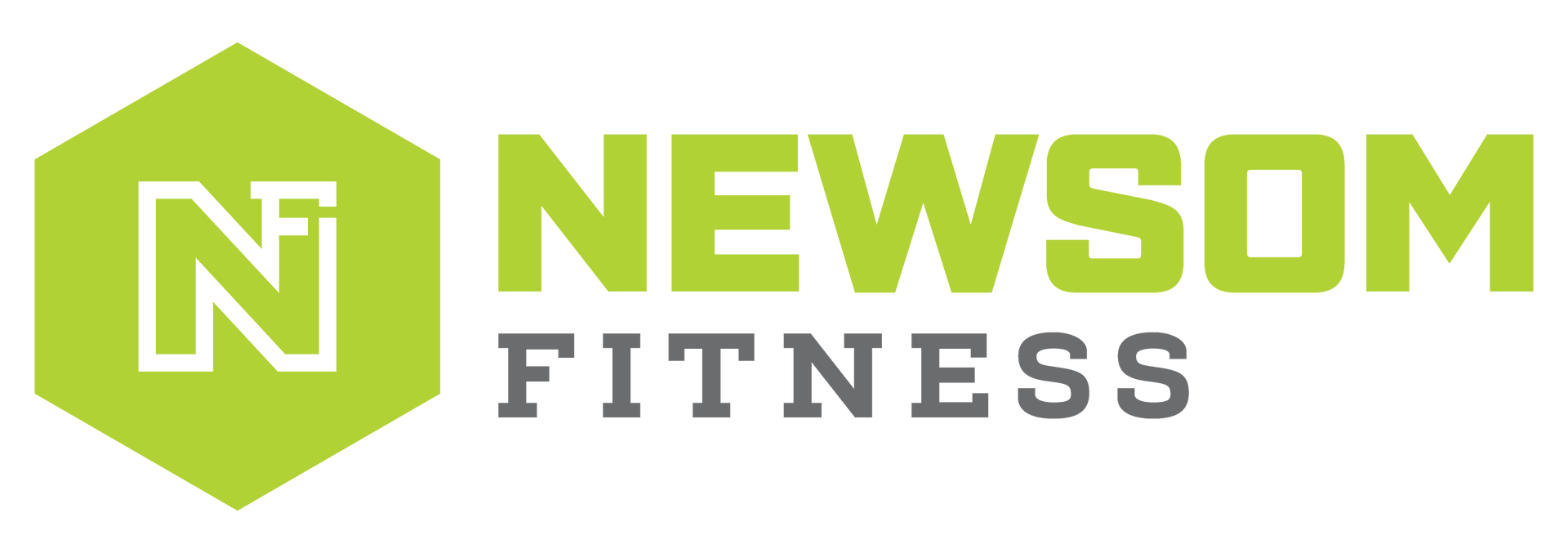Meet Newsom Fitness: Your Partner in Lifelong Health and Wellness
As we move into the next phase of life, whether it's during or after menopause, or simply approaching midlife, the way we nourish and care for our bodies becomes increasingly important. This chapter of life brings a unique set of challenges, including changes in metabolism, hormone levels, muscle mass, and energy. However, by focusing on both nutrition and fitness, you can keep your body energized, maintain your vitality, and live a long, healthy, and fulfilling life.
At Newsom Fitness, we believe that this phase of life is an opportunity to take charge of your health by making informed decisions about your diet and exercise routine. In this blog, we’ll explore how nutrition and fitness work hand-in-hand to support energy, resilience, and longevity during and after menopause for women, and we’ll offer tips that men can use as they navigate their own midlife transitions.
Understanding How Your Body Changes During Menopause and Midlife
Menopause is a natural biological process that marks the end of a woman’s reproductive years. It is defined by the cessation of menstruation for 12 consecutive months, typically occurring between the ages of 45 and 55. During this time, women experience a sharp decline in estrogen, which can lead to various physical and emotional changes, including:
- Slower metabolism: Hormonal changes can slow metabolism, leading to weight gain and making it harder to lose weight.
- Loss of muscle mass: The natural aging process and hormonal shifts contribute to a decline in muscle mass and strength, a condition known as sarcopenia.
- Bone density loss: Reduced estrogen levels increase the risk of osteoporosis and fractures.
- Energy dips: Many women experience fatigue or low energy during menopause due to hormonal changes, sleep disturbances, and stress.
While these changes are most commonly associated with women, men also go through their own midlife hormonal changes, often referred to as andropause, characterized by a gradual decline in testosterone levels. This can lead to:
- Increased body fat and reduced muscle mass: As testosterone decreases, it can become more difficult to maintain muscle and manage weight.
- Lower energy levels: Hormonal changes can also contribute to fatigue and lower energy.
- Mood changes: Like women, men may experience mood fluctuations or feelings of depression during this time.
The good news is that by making thoughtful adjustments to your nutrition and fitness routine, you can mitigate the impact of these changes and continue to thrive.
What you eat has a profound impact on how you feel and how your body functions, especially during times of hormonal change. By focusing on nutrient-rich foods that support energy, muscle health, and hormonal balance, you can fuel your body for the next chapter of life.
1. Prioritize Protein for Muscle Health
Protein is essential for building and maintaining muscle mass, which naturally declines with age. Consuming enough protein is especially important during menopause and midlife because it helps counteract muscle loss and supports metabolic function.
- Why Protein Matters: As we age, our bodies become less efficient at utilizing protein, which means we need more of it to maintain muscle mass. Protein also helps with tissue repair, immune function, and hormone production.
- How to Get More Protein: Incorporate high-quality sources of protein into your meals, such as lean meats, poultry, fish, eggs, tofu, legumes, and dairy products like Greek yogurt. Aim for 20 to 30 grams of protein per meal to support muscle maintenance and overall health.
2. Focus on Healthy Fats for Hormonal Balance
Hormonal balance is critical during menopause and midlife, and healthy fats play a key role in supporting this. Omega-3 fatty acids, in particular, help reduce inflammation, support brain health, and promote hormonal health.
- Why Healthy Fats Matter: Healthy fats, especially omega-3s, are crucial for reducing inflammation, promoting heart health, and maintaining cell function. They also support hormonal health by helping to regulate the production of key hormones.
- How to Get More Healthy Fats: Incorporate sources of omega-3s like fatty fish (salmon, mackerel, sardines), chia seeds, flaxseeds, and walnuts into your diet. Other healthy fats, such as avocados, olive oil, and nuts, also support overall well-being.
3. Eat Fiber-Rich Foods for Digestion and Heart Health
As we age, digestion can slow down, and we become more susceptible to digestive issues like constipation. Additionally, fiber is essential for heart health and helps maintain stable blood sugar levels.
- Why Fiber Matters: Fiber supports digestive health, helps manage weight by promoting fullness, and reduces the risk of heart disease. It also helps regulate blood sugar levels, which is important for energy and metabolism.
- How to Get More Fiber: Fill your plate with fiber-rich foods like vegetables, fruits, whole grains, legumes, and seeds. Aim for at least 25 to 30 grams of fiber per day to support digestive and heart health.
4. Stay Hydrated
Hydration becomes more important as we age, particularly during menopause when hormonal fluctuations can lead to dehydration. Proper hydration helps maintain energy levels, support digestion, and regulate body temperature.
- Why Hydration Matters: Water is essential for nearly every bodily function, from digestion to circulation. Staying hydrated helps maintain energy levels, support cognitive function, and prevent fatigue.
- How to Stay Hydrated: Aim to drink at least 8 glasses of water a day, and increase your intake if you're active or live in a hot climate. You can also stay hydrated by eating water-rich foods like cucumbers, watermelon, and leafy greens.
5. Balance Your Blood Sugar
Maintaining stable blood sugar levels is crucial for sustained energy throughout the day. Blood sugar fluctuations can lead to energy crashes and cravings, which can be particularly challenging during menopause.
- Why Blood Sugar Matters: When blood sugar levels spike and crash, it can leave you feeling fatigued and irritable. Stabilizing your blood sugar through balanced meals and snacks can help maintain steady energy levels.
- How to Balance Blood Sugar: Focus on meals that combine protein, healthy fats, and fiber. Avoid processed sugars and refined carbohydrates, which can lead to energy crashes. Instead, opt for complex carbohydrates like whole grains, sweet potatoes, and legumes, which provide sustained energy.
The Role of Fitness in Supporting Energy and Vitality
Just as nutrition plays a key role in fueling your body, fitness is essential for maintaining strength, energy, and vitality as you age. Regular physical activity helps manage weight, preserve muscle mass, support cardiovascular health, and improve mood—all of which are crucial for thriving during and after menopause or midlife.
1. Strength Training to Maintain Muscle Mass
As we age, muscle mass naturally declines, making strength training an important part of any fitness routine. Strength training helps maintain and build muscle, boosts metabolism, and supports bone health.
- Why Strength Training Matters: Muscle loss (sarcopenia) is a common issue during menopause and midlife. Strength training counteracts this loss, helping you maintain strength, mobility, and metabolism.
- How to Incorporate Strength Training: Aim for at least two to three strength training sessions per week. Focus on compound exercises that work multiple muscle groups, such as squats, deadlifts, push-ups, and rows. Resistance bands, bodyweight exercises, and free weights are all great tools for strength training.
2. Cardiovascular Exercise for Heart Health and Energy
Cardiovascular exercise is essential for maintaining heart health, improving circulation, and boosting energy levels. Regular cardio can help reduce the risk of heart disease, which becomes more prevalent during and after menopause, and improves overall stamina.
- Why Cardio Matters: Cardio workouts improve the efficiency of your cardiovascular system, helping to deliver oxygen to your muscles and organs. This leads to increased energy and endurance for daily activities.
- How to Incorporate Cardio: Aim for at least 150 minutes of moderate-intensity cardio each week. Activities like brisk walking, swimming, cycling, or dancing are excellent options for getting your heart rate up and boosting energy.
3. Flexibility and Balance for Mobility and Injury Prevention
Flexibility and balance exercises are often overlooked but are crucial for maintaining mobility and preventing injuries, particularly as we age. Incorporating yoga, Pilates, or stretching into your routine can improve joint health, flexibility, and coordination.
- Why Flexibility Matters: As we age, our joints and muscles can become stiff, which can limit mobility and increase the risk of injury. Stretching and flexibility exercises help maintain range of motion and reduce tension.
- How to Incorporate Flexibility Training: Include flexibility exercises in your routine at least three times a week. Practices like yoga or Pilates not only improve flexibility but also enhance balance, posture, and overall body awareness.
4. Stress Reduction for Hormonal Health
Chronic stress can wreak havoc on your hormonal balance, particularly during menopause. Exercise is one of the most effective ways to manage stress, reduce cortisol levels, and promote relaxation.
- Why Stress Management Matters: High cortisol levels, often caused by chronic stress, can lead to weight gain, especially around the abdomen, and disrupt hormonal balance. Managing stress through exercise helps regulate cortisol and improve mood.
- How to Incorporate Stress Reduction: Incorporate activities like yoga, meditation, deep breathing exercises, or walking in nature to reduce stress and improve emotional well-being. Even 10 to 15 minutes of mindfulness practice each day can help regulate stress and support hormonal health.
Conclusion: Fueling Your Body for the Next Chapter
At Newsom Fitness, we believe that midlife and menopause are opportunities to prioritize your health and well-being in new and empowering ways. By focusing on nutrition and fitness, you can support your body’s energy, vitality, and longevity, allowing you to thrive in this next chapter of life.
For both men and women, the strategies outlined here—incorporating nutrient-rich foods, staying active with strength and cardio training, and managing stress—are key to maintaining strength, resilience, and energy as you age. By fueling your body with the right nutrition and exercise, you can embrace the changes of midlife and continue living a vibrant, fulfilling life.
No matter your age or stage in life, it’s never too late to start prioritizing your health. Stay active, eat well, and nurture your body and mind for a strong and energized future.




